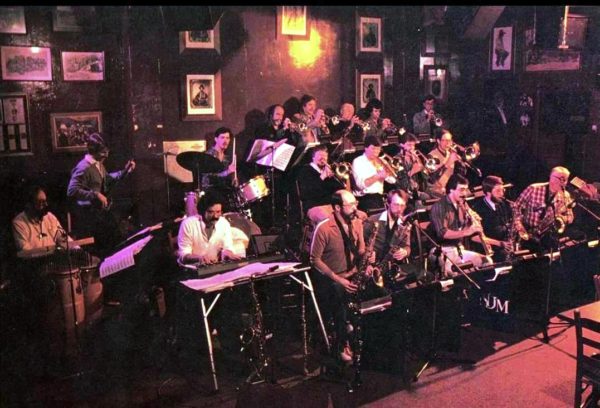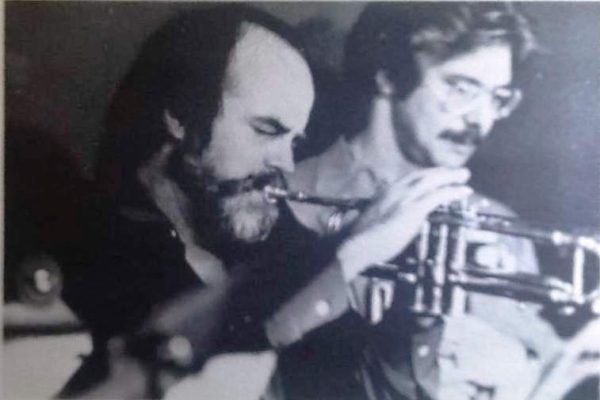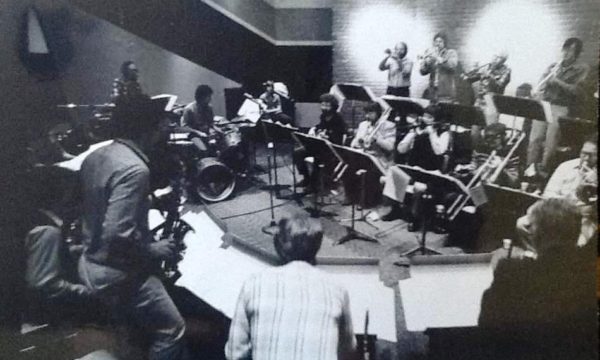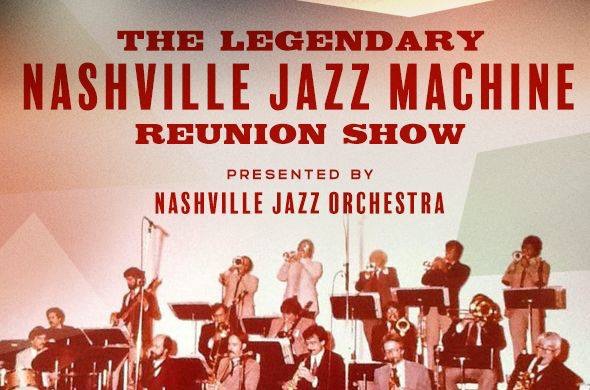
The reunion of the Nashville Jazz Machine serves as a potent reminder of what one man’s—and one band’s—crusade can create.
The saga of jazz in Nashville spans many years of near-obscurity amidst a music industry that offered little opportunity for jazz-minded players to fully toot their horns. Their chance would ultimately arrive in the form of a nationwide jazz explosion beginning in the mid-1970s, a wind of mainstream interest that not only blew open the doors for local jazzers but, more significantly, put a sizeable dent in the flimsy premise that Nashville only had eyes for gospel and country. For those of us who weren’t around to witness those heady days, there’s good news: the Nashville Jazz Machine, the spit-valve spark plug that first revved Music City’s jazz revolution into high gear, is planning a historic reunion show at Nashville’s City Winery on Monday, Aug. 5. Fittingly, the show will feature not only core members but also latter-day alumni and younger musicians who followed in their wake—because the fact is that today’s Nashville jazz scene can be directly traced to the massive footprint the Machine left behind.
The Nashville Jazz Machine was built, however unintentionally at first, by trumpet player Dave Converse, who arrived fresh out of Louisiana Tech in 1971. While Converse did graduate work at Peabody College, he scoped out the recording scene and encountered a level of musicianship that was “just a shock,” he recalls. “I had no idea anybody existed anywhere on that level. And I’ve been a fan of the musicians in Middle Tennessee ever since.” The first time he heard esteemed local trumpeter George Tidwell play, Converse said he had two conflicting thoughts: “Jesus, I’m in the wrong place!” and “Jesus, I’m in exactly the right place!”
Early on, he accepted a position as assistant first trumpet player with the Nashville Symphony. Soon, he learned that the symphony world and the commercial/studio worlds were . . . well, worlds apart. Converse was fully qualified to play classical music, and he enjoyed it, making valuable relationships during his brief symphonic stint. The fact of the matter was that, for reasons Converse never fully understood, the city’s classical musicians simply didn’t cross the line into commercial work. Neither did they dabble in jazz, though as trained players they most likely possessed the technique to do so. Converse found particular pleasure in showing up at a session “not knowing what you were going to have to do, but knowing you could do it. There was an excitement in that,” says Converse, who left the symphony to pursue regular session work.
By the late 1960s there was a growing contingent of college-educated brass and wind instrumentalists working on Music Row, pro players whose ability surpassed what was required for the average recording session. Converse confirms that “there were more kinds of music here than country music back then. It was just that country music was what got all the discussion.” Due to country’s prominence, the rumblings of musical diversity during that time remained dim in comparison, creating a particularly low ceiling for jazz-minded musicians.
“Many genres of music have been, and are, recorded in Nashville,” explains producer and engineer Travis Turk. “Since the early days when big bands toured, some stopped long enough to record, so Nashville has a history of knowing how to record many types of music,” says Turk. A longtime Nashville audio professional and a proponent of recording musicians all in the same room at the same time (yeah, they used to do it that way, kids), Turk captured the Machine at their peak in 1984 on the still-vital progressive jazz album Where’s Eli, cut live to tape in two three-hour sessions at the famed but since-razed Sound Shop. The album, released on the Los Angeles jazz label am-pm Records, is still sought by collectors.
https://www.youtube.com/watch?v=MrUC0aqNeRQ
“As the music industry grew in Nashville,” continues Turk, “there was a need for more than just guitars, and ‘jazzers’ came to here to make a living. As this group grew, they needed an outlet to express the music they loved but didn’t get to record much of,” says Turk, who recalls being “blown away” the first time he dropped by to hear the NJM rehearse. Indeed, when musicians of this caliber are called upon to add simple ornamentation to a pop or country record, it’s a little like delivering pizza in a turbocharged 1969 Camaro. Every so often, you just need to hit an open stretch of asphalt and blow the dust out.
“Back in those days there wasn’t much [jazz] going on,” Converse confirms. “There was always an undercurrent. There were people who were just carrying the torch. There was a big band—as there’s gonna be when you run into any music center—called a rehearsal band. Another word for it is ‘kicks band,’” Converse continues, “because that’s exactly what it is. It’s a band that’s just there for kicks. The band is too big to make money [playing nightclub shows]; the music that you’re playing is really for the musicians.”
The premier “kicks band” at the time was The Jazz Corporation, a collection of the city’s A-team session players led by trumpet player and arranger Barry McDonald.
“They did a lot of original music and it was just really great stuff,” says Converse, who was one of the younger players that religiously attended the Corporation’s sporadically scheduled Sunday get-togethers at the old Musicians Union hall on Demonbreun Street. “We would show up there and pray somebody would let us play a tune or two . . . let us play with grown-ups, you know?” says Converse, letting loose a raucous laugh.
Converse, who remembers lamenting the lack of jazz in his musical menu with trombonist buddy Terry Williams while driving home from a weekend road gig playing respectable but ultimately uninspiring music, formed a kicks band with Williams’ help in 1975. Rehearsals commenced in the Vanderbilt University band room, courtesy of their pianist, John Legg—Vandy’s assistant band director and leader of the school’s jazz ensemble, who offered not only a rehearsal space but also access to a sizeable music library. “We put together a bunch of stock charts,” Converse begins. “We would just read charts, drink beer, read charts, drink beer and enjoy ourselves. But the key is that it was every Monday night. It wasn’t that we were trying to get all that good, it was just that we wanted to do it. We didn’t get to play that stuff any other time,” Converse says, “and Barry’s band was gettin’ together maybe every two months. And we were selfish.”
The story would probably have ended there had it not been for an all-jazz event held in 1976 at Belmont College (now University) that Converse’s former trumpet teacher Del Sawyer urged him to participate in. “I said hell, no! We’re not ready for public consumption, man, we’re just a bunch of good-timers here, you know?” Converse put the decision up for a vote, and his fellow musicians chose to do the concert, despite Converse’s reluctance to play on a bill headed up by none other than The Jazz Corporation. “My reaction was ‘Y’all are absolutely crazy! Don’t you realize we’ll be right in front of [George] Tidwell and all these other guys? Man, they’re gonna be up there just playin’ their butts off and we’ll be playing these Buddy Rich charts and stuff you do in school!”
To this day, it’s not clear if Converse is more surprised that the band went over like gangbusters or that George Tidwell told Converse afterwards that he wanted to join the band, a statement the bandleader initially thought was just the trumpet player’s way of being nice. Not only was Tidwell serious, but he waited patiently for a slot to open up. Converse, you see, wasn’t willing to eject one of his band members even for a player he describes as “the definition of the jazz trumpet sound out of the southeastern United States. He’s a lot of things, but he is probably the most valuable recording session musician I’ve ever been around.”

George Tidwell (left) takes a solo with the Nashville Jazz Machine, seated next to NJM founding member and then-bandleader Dave Converse.
Tidwell, whose 1960s rehearsal and concertizing band Orchestra XII preceded both The Jazz Corporation and Converse’s young bunch of upstarts, offers his perspective on what made the Nashville Jazz Machine so special. “Because of Dave’s amazing gift as a leader—the best I’ve played with—coupled with the influx of fine younger players to town, his group quickly developed a following and became a group that just about everyone, including me, wanted to be a part of. The rest is kind of local history,” continues Tidwell, “as the NJM surpassed and outlasted anything that had come before.
“The success of the band was of course due in large part to a roster of amazing players, but no doubt to me that the ultimate difference was Dave’s gift at picking music and personnel, rehearsing the band so well and always following through with enthusiasm,” Tidwell says. “Plus, he was a fine trumpet player! I’m happy to say that once I got aboard I had a long run of the most big-band fun I’ve ever had. I don’t think I ever missed a gig!”

The Nashville Jazz Machine cranks it out during one of their Monday night rehearsals, sometime around 1979 or 1980.
The tide began to turn for the band at that point, serendipitously aided by a growing jazz presence that appeared in mainstream popular music beginning in the latter half of the ’70s, with artists such as guitarist George Benson and flugelhorn artist Chuck Mangione scoring sophisticated jazz-pop crossover hits. Nashville, being blessed with an embarrassment of musical riches, experienced an eruption of jazz activity that brought forth a cast of smaller combos and more venues willing to take a chance on a genre that had not formerly proven to be economically viable. New venues began popping up as well and hosting jazz. “It was kinda like New York,” Converse says.
Standing at the forefront of this shift was the Nashville Jazz Machine, an 18-piece powerhouse that at first implausibly began to draw crowds to the storied Exit/In nightclub on the city’s west side. “There were jazz groups before, as there would always be where musicians congregate,” Converse says. “But it was always in the shadows and spoken of in whispers.” The NJM, Converse affirms, was “the first one that really got in front of the public and said ‘Here we are, folks, we’re not hidin’ in the closet anymore.’”
The rise in local popularity didn’t change the fact that a large band still couldn’t make decent money playing clubs, though, and Converse had to make a passionate appeal to the president of the Musicians Union, who told the bandleader he needed to pay his players at the typical rate. “I told him, ‘If you make me do that, all you’re gonna do is just snuff out a little more jazz in town, man. Just let us play for the door! I came here to ask for your blessing.’ And he got silent, and he was looking me right in the eye, and I knew I had him.” Converse had his guys write it into their Union contracts that they were willing to play for the cover charge, which marked the end of that discussion. “Jazz is a crusader’s mission. You’ve got to want to do it, you’ve got to love it to do it, ’cause you’re sure not gonna get rich doing it.”
https://www.youtube.com/watch?v=PE2z7vne22w
The Exit/In became a hub for a thriving jazz community in the late ’70s after kicking off a Sunday night series that grew into a weekly broadcast on WPLN-FM, initiated by the NPR station’s general manager, Cal Bean. Following the broadcast was a late-evening jam that allowed new players to meet and sit in with established musicians, offering the same opportunity that The Jazz Corporation had given to Converse and his peers in the early ’70s. Converse also welcomed players to the Monday night sessions and would agree to play through brand-new compositions, allowing young composers and arrangers the invaluable opportunity to hear what worked and what needed to be revised. If the NJM members agreed that they liked a new piece, the band would add it to their repertoire, a thrilling experience for composers in search of exposure.
When a club owner wanted to book a jazz band, the call usually went to Converse. When a new horn player came to town, the Union would direct them straight to the bandleader, who had unwittingly become the scene’s go-to godfather. He remembers someone calling him a mover and shaker, and says he was initially insulted, because he didn’t know what the term even meant. “People thought I was the guru of all the horn work in town . . . I was never. I was just scuffling to make a living like everyone else.” But Converse agrees that the NJM helped to galvanize a tight-knit jazz community that continues today.
Acclaimed saxophonist Denis Solee, who was new to town just as the NJM’s star began its rise, found a ready spotlight for his immense talent after replacing a departing NJM member. Converse even experimented briefly with starting a jazz label, NJP Records, which yielded a collaboration between soloists Tidwell and Solee in a group known as Earwitness. The title of their sole release, The Secret’s Out, was, as Converse reveals, an allusion to the coming-out of Nashville’s jazzier contingent. After George Tidwell became a regular Machine member somewhere around 1977, a long, gradual transition ensued, with the NJM and Jazz Corporation naturally melding into one happy family of Nashville cats who were in it strictly for the satisfaction, not for status or networking opportunities. “It was a chance to do this music that we really enjoyed,” says Solee.
For the September 1980 opening of the Tennessee Performing Arts Center, created as a symbol of Nashville’s underrecognized artistic and musical diversity and world-class musician base, the NJM was chosen as its inaugural act. A week later, again on the TPAC stage, the band backed celebrated jazz vocalist Mel Torme. Known as a performer with high expectations who didn’t suffer fools gladly, Torme further validated the Machine with glowing praise, both on the stage and later in an interview with Billboard magazine, regarded as the industry bible.
“He was thrilled with the quality of the ensemble playing,” recalls Denis Solee, while Converse remembers that Torme “made it a point to praise the band throughout the rehearsal and performance, several times and referring us to the audience as ‘your own Nashville Jazz Machine.’”
When Converse began to struggle to play the trumpet to his satisfaction, an issue likely brought on by excessive high-volume and high-register playing, he was forced to reconsider his career path. In an agonizing decision, he handed the NJM charts over to Solee and Tidwell, and set about finding another way to support his growing family. As a result, he doesn’t know much about what happened to the band after his departure sometime in the mid-’80s. “The only way I could survive that major life change,” he says, “was to make a clean break and move on. As hard as it was, I had no choice. But to this very day, if you cut me open you’d see nothing inside but a trumpet player who’s been in there since I was 10 years old.”
Solee recalls the band “just fizzling out” after a period of time under a shifting series of short-term leaders. “Dave’s energy was missed, I’ll put it that way,” he says. “He made sure it happened. Not everyone else was as dogmatic about rehearsing regularly and finding gigs.”
The reunion concert, Converse reports, will feature most of the core members along with guests and latter-day NJM members who, he notes, “have grown into distinguished careers as Nashville’s ‘A-team’ of musicians.” Former members, some of whom have gone on to successful gigs in L.A. and on Broadway, will be traveling back for the show, as will musicians from virtually every section of the country. Converse’s return to the stage with the NJM—he reports that he’s worked up enough trumpet chops to play at least a few numbers with the guys—is bound to be memorable, even poignant. But the opportunity to reassemble the old gang has allowed him to gain a new perspective.
“At the time of the NJM’s emergence and the other jazz groups that coincided with it, I don’t think we were conscious of how unique that time would turn out to be. I guess we just considered it the natural flow of events, if we thought about it at all. With the proceeding evolution of jazz and other adventurous music in Nashville, hindsight really makes all of us realize how special it was to be part of the ignition of that movement.

Converse, who owns the trademark on the term “Nashville jazz,” has freely shared it with deserving entities including the Nashville Jazz Orchestra and the Nashville Jazz Workshop, a nonprofit Converse notes he’s very proud of for their work in making jazz accessible to musicians and fans of all levels and offering top-notch instruction and support. The whole concept of “Nashville jazz,” once an oxymoron, grew from his outraged refusal to accept a piece of advice from a record company executive. “He told me, ‘Don’t use the words “Nashville” and “jazz” in the same paragraph. Nobody will take you seriously.’ And he meant it! And I thought about it and I said, ‘You just said that to the wrong dude, man. I’m gonna say “Nashville jazz” till the day I draw my last breath.’”
A miniature history of contemporary Nashville jazz—now a fully credible term—exists within the alumni of the NJM and those who followed them. “With the advantage of hindsight, we look back and know that it’s our legacy being at the time and place to be influential in bringing the ‘secret’ out in the light of day. Those efforts also induced many younger players and arrangers to come to Nashville, players not chasing careers in country music. Seems like we raised the bar,” Converse reckons, “and inspired others to raise it even further. For that, it’s a legacy we can be proud of.”

The Legendary Nashville Jazz Machine Reunion Show, presented by the Nashville Jazz Orchestra, takes place at 7 p.m. at City Winery in Nashville. Tickets are $18 at the door. Advance tickets are $15 and are available at citywinery.com/nashville.













